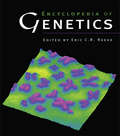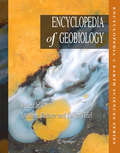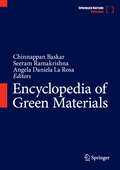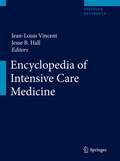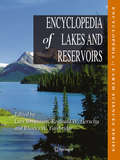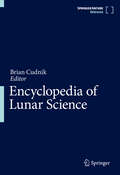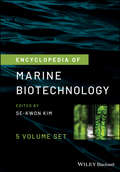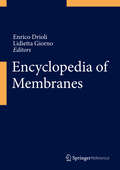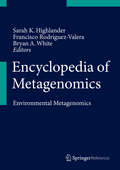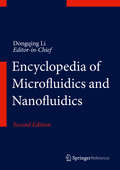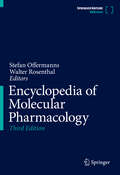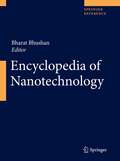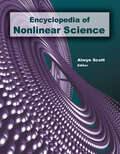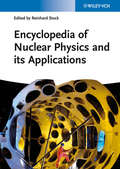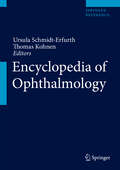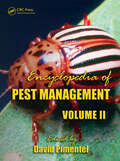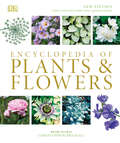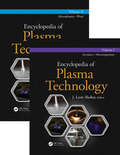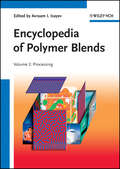- Table View
- List View
Encyclopedia of Genetics
by Eric C.R Reeve Isobel BlackThe Encyclopedia includes 125 entries, beginning with the origins of genetics including historical background on the work of Gregor Mendel and Charles Darwin, and progressing to the structure of DNA and modern theories such as selfish genes. All branches of genetics are covered, including the genetics of bacteria, viruses, insects, animals and plants, as well as humans. Important topical issues such as the human genome project, bioethics, the law and genetics, genetic disorders, GM crops, and the use of transgenic animals for food and pharmaceutical products are fully surveyed. A section on techniques and biotechnology includes modern methods of analysis, from DNA fingerprinting to the new science of bioinformatics. The articles, all written by specialists, are largely non-mathematical and progress from general concepts to deeper understanding. Each essay is fully referenced, with suggestions for further reading. The text is supplemented by extensive illustrations, tables and a color plate section. The Encyclopedia of Genetics will be a valuable companion for all those working or studying in the various fields of genetical research, and a fascinating reference for all readers with a basic background in biology. Also includes color inserts.
Encyclopedia of Geobiology
by H. W. Fritz Pamela Reid Xingliang Zhang Joachim Reitner Andreas Kappler Volker Thiel Kurt KonhauserThe interplay between Geology and Biology has shaped the Earth from the early Precambrian, 4 billion years ago. Moving beyond the borders of the classical core disciplines, Geobiology strives to identify chains of cause-and-effect and synergisms between the geo- and the biospheres that have been driving the evolution of life in modern and ancient environments. Combining modern methods, geobiological information can be extracted not only from visible remains of organisms, but also from organic molecules, rock fabrics, minerals, isotopes and other tracers. An understanding of these processes and their signatures reveals enormous applied potentials with respect to issues of environment protection, public health, energy and resource management. The Encyclopedia of Geobiology has been designed to act as a key reference for students, researchers, teachers, and the informed public and to provide basic, but comprehensible knowledge on this rapidly expanding discipline that sits at the interface between modern geo- and biosciences.
Encyclopedia of Geochemistry: A Comprehensive Reference Source on the Chemistry of the Earth (Encyclopedia of Earth Sciences Series)
by William M. White William H. Casey Bernard Marty Hisayoshi YurimotoThe Encyclopedia is a complete and authoritative reference work for this rapidly evolving field. Over 300 international scientists, each experts in their specialties, have written over 330 separate topics on different aspects of geochemistry including geochemical thermodynamics and kinetics, isotope and organic geochemistry, meteorites and cosmochemistry, the carbon cycle and climate, trace elements, geochemistry of high and low temperature processes, and ore deposition, to name just a few. The geochemical behavior of the elements is described as is the state of the art in analytical geochemistry. Each topic incorporates cross-referencing to related articles, and also has its own reference list to lead the reader to the essential articles within the published literature. The entries are arranged alphabetically, for easy access, and the subject and author indices are comprehensive and extensive.Geochemistry applies chemical techniques and approaches to understanding the Earth and how it works. It touches upon almost every aspect of earth science, ranging from applied topics such as the search for energy and mineral resources, environmental pollution, and climate change to more basic questions such as the Earth’s origin and composition, the origin and evolution of life, rock weathering and metamorphism, and the pattern of ocean and mantle circulation. Geochemistry allows us to assign absolute ages to events in Earth’s history, to trace the flow of ocean water both now and in the past, trace sediments into subduction zones and arc volcanoes, and trace petroleum to its source rock and ultimately the environment in which it formed. The earliest of evidence of life is provided by chemical and isotopic traces, not fossils, preserved in rocks. Geochemistry has allowed us to unravel the history of the ice ages and thereby deduce their cause. Geochemistry allows us to determine the swings in Earth’s surface temperatures during the ice ages, determine the temperatures and pressures at which rocks have been metamorphosed, and the rates at which ancient magma chambers cooled and crystallized. The field has grown rapidly more sophisticated, in both analytical techniques that can determine elemental concentrations or isotope ratios with exquisite precision and in computational modeling on scales ranging from atomic to planetary.
Encyclopedia of Green Materials
by Seeram Ramakrishna Chinnappan Baskar Angela Daniela La RosaEncyclopedia of Green Materials covers comprehensive overview, recent research and development of Green Materials and Green Nanomaterials, and their applications in all areas, including electronics, sensors, textiles, biomedical, energy and energy storage, building constructions and interiors design, automotive, green plastic manufacturing, food packing, membrane technology, wastewater treatment, rubber technology, and tire manufacturing. The contents focus on sustainable development, renewable, circular economy, Chemistry 4.0: Chemistry through innovation in transforming the world, green chemistry and green engineering, upcycling, and recycling.
Encyclopedia of Intensive Care Medicine
by Jesse B. Hall Jean-Louis VincentThe aim of this comprehensive encyclopedia is to provide detailed information on intensive care medicine contributing to the broad field of emergency medicine. The wide range of entries in the Encyclopedia of Intensive Care Medicine are written by leading experts in the field. They will provide basic and clinical scientists in academia, practice, as well as industry with valuable information about the field of intensive care medicine, but also people in related fields, students and teachers will benefit from the important and relevant information on the most recent developments in emergency medicine. The Encyclopedia will contain 4 volumes, and published simultaneously online. The entire field has been divided into 14 sections. All entries will be arranged in alphabetical order with extensive cross-referencing between them.
Encyclopedia of Lakes and Reservoirs
by Lars Bengtsson Rhodes W. Fairbridge Reginald W. HerschyLakes and reservoirs hold about 90% of the world's surface fresh water, but overuse, water withdrawal and pollution of these bodies puts some one billion people at risk. The Encyclopedia of Lakes and Reservoirs reviews the physical, chemical and ecological characteristics of lakes and reservoirs, and describes their uses and environmental state trends in different parts of the world. Superbly illustrated throughout, it includes some 200 entries in a range of topics, including acidification, artificialisation, canals, climate change effects, dams, dew ponds, drainage, eutrofication, evaporation, fisheries, hydro-electric power, nutrients, organic pollution, paleolimnology, reservoir capacities and depths, sedimentation, water resources and more.
Encyclopedia of Lunar Science
by Brian CudnikThe Encyclopedia of Lunar Science includes the latest topical data, definitions, and explanations of the many and varied facets of lunar science. This is a very useful reference work for a broad audience, not limited to the professional lunar scientist: general astronomers, researchers, theoreticians, practitioners, graduate students, undergraduate students, and astrophysicists as well as geologists and engineers. The title includes all current areas of lunar science, with the topical entries being established tertiary literature. The work is technically suitable to most advanced undergraduate and graduate students. The articles include topics of varying technical levels so that the top scientists of the field find this work a benefit as well as the graduate students and the budding lunar scientists. A few examples of topical areas are as follows: Basaltic Volcanism, Lunar Chemistry, Time and Motion Coordinates, Cosmic Weathering through Meteoritic Impact, Environment, Geology, Geologic History, Impacts and Impact Processes, Lunar Surface Processes, Origin and Evolution Theories, Regolith, Stratigraphy, Tectonic Activity, Topography, Weathering through ionizing radiation from the solar wind, solar flares, and cosmic rays.
Encyclopedia of Marine Biotechnology
by Se-Kwon KimA keystone reference that presents both up-to-date research and the far-reaching applications of marine biotechnology Featuring contributions from 100 international experts in the field, this five-volume encyclopedia provides comprehensive coverage of topics in marine biotechnology. It starts with the history of the field and delivers a complete overview of marine biotechnology. It then offers information on marine organisms, bioprocess techniques, marine natural products, biomaterials, bioenergy, and algal biotechnology. The encyclopedia also covers marine food and biotechnology applications in areas such as pharmaceuticals, cosmeceuticals, and nutraceuticals. Each topic in Encyclopedia of Marine Biotechnology is followed by 10-30 subtopics. The reference looks at algae cosmetics, drugs, and fertilizers; biodiversity; chitins and chitosans; aeroplysinin-1, toluquinol, astaxanthin, and fucoxanthin; and algal and fish genomics. It examines neuro-protective compounds from marine microorganisms; potential uses and medical management of neurotoxic phycotoxins; and the role of metagenomics in exploring marine microbiomes. Other sections fully explore marine microbiology, pharmaceutical development, seafood science, and the new biotechnology tools that are being used in the field today. One of the first encyclopedic books to cater to experts in marine biotechnology Brings together a diverse range of research on marine biotechnology to bridge the gap between scientific research and the industrial arena Offers clear explanations accompanied by color illustrations of the techniques and applications discussed Contains studies of the applications of marine biotechnology in the field of biomedical sciences Edited by an experienced author with contributions from internationally recognized experts from around the globe Encyclopedia of Marine Biotechnology is a must-have resource for researchers, scientists, and marine biologists in the industry, as well as for students at the postgraduate and graduate level. It will also benefit companies focusing on marine biotechnology, pharmaceutical and biotechnology, and bioenergy.
Encyclopedia of Membranes
by Lidietta Giorno Enrico DrioliA landmark work covering the major aspects of the science, technology and application of membrane operations and related fields, from basic phenomena to the most advanced applications and future perspectives. Over 1100 concise entries in an A-Z format cover a vibrant field with a multitude of applications in diverse disciplines such as biotechnology, medicine, agro-food and petrochemical industries, environmental protection, as well as drinking water supply. Coverage includes membrane reactors and catalytic design (catalytic membrane reactors). Practically all unit operations of process engineering can be redesigned as membrane unit operations (e. g. membrane distillation, membrane crystallization, membrane stripping, membrane scrubbing). Entries are provided by an international team of experts from academia, research institutions as well as from industry.
Encyclopedia of Metagenomics
by Sarah K. Highlander Francisco Rodriguez-Valera Bryan A. WhiteMetagenomics has taken off as one of the major cutting-edge fields of research. The field has broad implications for human health and disease, animal production and environmental health. Metagenomics has opened up a wealth of data, tools, technologies and applications that allow us to access the majority of organisms that we still cannot access in pure culture (an estimated 99% of microbial life). Numerous research groups are developing tools, approaches and applications to deal with this new field, as larger data sets from environments including the human body, the oceans and soils are being generated. See for example the human microbiome initiative (HMP) which has become a world-wide effort and the Global Ocean Sampling (GOS) surveys. The number of publications as measured through PubMed that are focused on metagenomics continues to increase. The field of metagenomics continues to evolve with large common datasets available to the scientific community. A concerted effort is needed to collate all this information in a centralized place. By having all the information in an Encyclopedia form, we have an opportunity to receive seminal contributions from the leaders in the field and at the same time provide this information to a significant number of junior and senior scientists, via colleges, libraries, and just through online access. This format also allows scientists in the developing world to have continued access to this growing field. It is anticipated that the Encyclopedia will also be used by many other groups including, clinicians, undergraduate and graduate level students, as well as ethical and legal groups associated with or interested in the issues surrounding metagenome science.
Encyclopedia of Metagenomics
by Karen E. NelsonMetagenomics has taken off as one of the major cutting-edge fields of research. The field has broad implications for human health and disease, animal production and environmental health. Metagenomics has opened up a wealth of data, tools, technologies and applications that allow us to access the majority of organisms that we still cannot access in pure culture (an estimated 99% of microbial life). Numerous research groups are developing tools, approaches and applications to deal with this new field, as larger data sets from environments including the human body, the oceans and soils are being generated. See for example the human microbiome initiative (HMP) which has become a world-wide effort and the Global Ocean Sampling (GOS) surveys. The number of publications as measured through PubMed that are focused on metagenomics continues to increase. The field of metagenomics continues to evolve with large common datasets available to the scientific community. A concerted effort is needed to collate all this information in a centralized place. By having all the information in an Encyclopedia form, we have an opportunity to gather seminal contributions from the leaders in the field, and at the same time provide this information to a significant number of junior and senior scientists. It is anticipated that the Encyclopedia will also be used by many other groups including, clinicians, undergraduate and graduate level students, as well as ethical and legal groups associated with or interested in the issues surrounding metagenome science.
Encyclopedia of Metalloproteins
by Vladimir N. Uversky Robert H. Kretsinger Eugene A. PermyakovIn biochemistry, a metalloprotein is a generic term for a protein that contains a metal cofactor. The metal may be an isolated ion or may be coordinated with a nonprotein organic compound, such as the porphyrin found in hemoproteins. In some cases, the metal is co-coordinated with a side chain of the protein and an inorganic nonmetallic ion. This kind of protein-metal-nonmetal structure is seen in iron-sulfur clusters Metalloproteins deals with all aspects related to the intracellular and extracellular metal-binding proteins, including their structures, properties and functions. The biological roles of metal cations and metal-binding proteins are endless. They are involved in all crucial cellular activities. Many pathological conditions are related to the problematic metal metabolism. Research in metalloprotein-related topics is therefore rapidly growing, and different aspects of metal-binding proteins progressively enter curricula at Universities and even at the High School level on occasion. However, no key resource providing basic, but comprehensible knowledge on this rapidly expanding field exists. The Encyclopedia of Metalloproteins aims to bridge this gap, and will attempt to cover various aspects of metalloprotein/metalloproteomics and will deal with the different issues related to the intracellular and extracellular metal-binding proteins, including their structures, properties and functions. The goal is to cover exhaustively all catalytically and biologically crucial metal ions and to find at least one interacting protein for other metal ions. The Encyclopedia of Metalloproteins will provide a key resource for advanced undergraduate and graduate students, researchers, instructors, and professors interested in protein science, biochemistry, cell biology, and genetics.
Encyclopedia of Microfluidics and Nanofluidics
by Dongqing LiCovering all aspects of transport phenomena on the nano- and micro-scale, the 800 entries include 300 essay entries. The Encyclopedia gives an up to date look at the fundamentals of the field as well as many experiments and applications in growing areas such as energy devices and bioengineering applications.
Encyclopedia of Modern Coral Reefs
by Peter Davies Colin Woodroffe David Hopley Eberhard Gischler Guy Cabioch † I. G. Macintyre Rachel Wood Terry DoneCoral reefs are the largest landforms built by plants and animals. Their study therefore incorporates a wide range of disciplines. This encyclopedia approaches coral reefs from an earth science perspective, concentrating especially on modern reefs. Currently coral reefs are under high stress, most prominently from climate change with changes to water temperature, sea level and ocean acidification particularly damaging. Modern reefs have evolved through the massive environmental changes of the Quaternary with long periods of exposure during glacially lowered sea level periods and short periods of interglacial growth. The entries in this encyclopedia condense the large amount of work carried out since Charles Darwin first attempted to understand reef evolution. Leading authorities from many countries have contributed to the entries covering areas of geology, geography and ecology, providing comprehensive access to the most up-to-date research on the structure, form and processes operating on Quaternary coral reefs.
Encyclopedia of Molecular Pharmacology
by Stefan Offermanns Walter RosenthalAn essential text, this is a fully updated second edition of a classic, now in two volumes. It provides rapid access to information on molecular pharmacology for research scientists, clinicians and advanced students. With the A-Z format of over 2,000 entries, around 350 authors provide a complete reference to the area of molecular pharmacology. The book combines the knowledge of classic pharmacology with the more recent approach of the precise analysis of the molecular mechanisms by which drugs exert their effects. Short keyword entries define common acronyms, terms and phrases. In addition, detailed essays provide in-depth information on drugs, cellular processes, molecular targets, techniques, molecular mechanisms, and general principles.
Encyclopedia of Nanotechnology
by Bharat BhushanThe Encyclopedia of Nanotechnology provides a comprehensive and multi-disciplinary reference to the many fields relevant to the general field of nanotechnology. It aims to be a comprehensive and genuinely international reference work and will be aimed at graduate students, researchers, and practitioners. The Encyclopedia of Nanotechnology introduces a large number of terms, devices and processes which are related to the multi-disciplinary field of Nanotechnology. For each entry in this 4 volume set a 4-10 page description is provided by an expert in the field. Contributions are made by experts from the US, Europe and Asia, making this a comprehensive and truly international Reference Work. The authors are typically from academia, however one quarter of all entries were written by persons from industry. Topics covered in the Reference Work include: - Nano- Microfabrication Processes and Materials for Fabrication - Nanoscale Measurement Techniques - Nanostructures - Nanomaterials - Nanomechanics - Molecular Modeling and Its Role in Advancing Nanotechnology - MEMS/NEMS - Microfluidics and Nanofluidics - Biomedical Engineering and Biodevices - Bio/Nanotechnology and Nanomedicine - Bio/Nanotechnology for cellular engineering - Drug Delivery - Technology and Applications - Assembly - Organic Electronics - Nano-optical Devices - Micro/nano Integration - Materials, Coatings and Surface Treatments for Nanotribology - Micro/NanoReliability - thermal, mechanical etc. - Biomimetics
Encyclopedia of Nonlinear Science
by Alwyn ScottIn 438 alphabetically-arranged essays, this work provides a useful overview of the core mathematical background for nonlinear science, as well as its applications to key problems in ecology and biological systems, chemical reaction-diffusion problems, geophysics, economics, electrical and mechanical oscillations in engineering systems, lasers and nonlinear optics, fluid mechanics and turbulence, and condensed matter physics, among others.
Encyclopedia of Nuclear Physics and its Applications (Encyclopedia of Applied Physics)
by Reinhard StockThis book fills the need for a coherent work combining carefully reviewed articles into a comprehensive overview accessible to research groups and lecturers. Next to fundamental physics, contributions on topical medical and material science issues are included.
Encyclopedia of Ophthalmology
by Ursula Schmidt-Erfurth Thomas KohnenRapid advances in pathogenetic insight, diagnostic and therapeutic modalities, and basic research continuously influence the state of the art in ophthalmology. This comprehensive encyclopedia offers a systematic and complete source of information including basic principles and novel updates, both clinical and scientific. The encyclopaedic format offers comprehensive access to focused information on all relevant topics in a clear and user-friendly manner. The spectrum ranges from short definitions, cross references, acronyms to disease chapters including epidemiology, symptoms and differential diagnosis, sections on diagnostic and therapeutic technologies, and comprehensive scientific summaries describing recent findings as well as results from relevant studies. The material is presented in a standardized, uniform and concise way throughout all clinical and academic sections. High-quality images highlight visual information and tables and graphs summarize important data. The encyclopaedia is available in book and electronic format which is linked to relevant ophthalmologic journals and is continuously updated. All chapters are authored by leading experts in the specific field. The target audiences are clinicians in ophthalmology and related specialties, researchers, and students.
Encyclopedia of Pest Management, Volume II
by David PimentelWith contributions from more than 200 esteemed international authorities and containing approximately 200 entries, the Encyclopedia of Pest Management, Volume II is a key reference for professionals in academia, industry, and government, as well as students at all levels. Containing completely new entries, this volume is designed to be regularly co
Encyclopedia of Plants and Flowers
by Christopher BrickellFind new gardening inspiration with this compelling updated encyclopedia for all gardening enthusiasts!Achieve that beautiful garden oasis you&’ve always dreamed of, and find endless inspiration and guidance for your garden to thrive with this gardening guide! This fully comprehensive yet easy-to-use informative planting guide is what every gardener needs on their bookshelf. Here&’s what you&’ll find inside: • A photographic catalog of 4,000 plants and flowers grouped by type, size, then color, allowing readers to browse and find the best plants for their garden • A detailed &“Plant Dictionary&” describes more than 8,000 species and varieties, and their ideal growing conditions • In the Introduction, a &“Plant Selector&” section lists ideal plants for particular growing conditions, like coastal areas, shady spots and different soil types • Fully updated text from garden plant specialists, with more than 1,380 new plants added, including the latest and most popular cultivars Discover perennials, bulbs, shrubs, trees, succulents and ornamental shrubs, all showcased in beautiful, full-color photography to help elevate your garden to the next level. Use the extensive plant dictionary to look up more than 8,000 plant varieties and the best growing conditions.Written by a team of more than 15 top horticultural specialists under the guidance of internationally renowned gardener and botanist Christopher Brickell, this gardening encyclopedia appeals to all levels of gardeners and continually inspires with achievable garden ideas.This informative yet inspirational book about gardening will appeal to beginners or more experienced gardeners interested in the latest cultivars and horticultural advice.
Encyclopedia of Plasma Technology - Two Volume Set
by J. Leon ShohetTechnical plasmas have a wide range of industrial applications. The Encyclopedia of Plasma Technology covers all aspects of plasma technology from the fundamentals to a range of applications across a large number of industries and disciplines. Topics covered include nanotechnology, solar cell technology, biomedical and clinical applications, electronic materials, sustainability, and clean technologies. The book bridges materials science, industrial chemistry, physics, and engineering, making it a must have for researchers in industry and academia, as well as those working on application-oriented plasma technologies. Also Available OnlineThis Taylor & Francis encyclopedia is also available through online subscription, offering a variety of extra benefits for researchers, students, and librarians, including: Citation tracking and alerts Active reference linking Saved searches and marked lists HTML and PDF format options Contact Taylor and Francis for more information or to inquire about subscription options and print/online combination packages.US: (Tel) 1.888.318.2367; (E-mail) e-reference@taylorandfrancis.comInternational: (Tel) +44 (0) 20 7017 6062; (E-mail) online.sales@tandf.co.uk
Encyclopedia of Polymer Applications, 3 Volume Set
by Munmaya MishraUndoubtedly the applications of polymers are rapidly evolving. Technology is continually changing and quickly advancing as polymers are needed to solve a variety of day-to-day challenges leading to improvements in quality of life. The Encyclopedia of Polymer Applications presents state-of-the-art research and development on the applications of polymers. This groundbreaking work provides important overviews to help stimulate further advancements in all areas of polymers. This comprehensive multi-volume reference includes articles contributed from a diverse and global team of renowned researchers. It offers a broad-based perspective on a multitude of topics in a variety of applications, as well as detailed research information, figures, tables, illustrations, and references. The encyclopedia provides introductions, classifications, properties, selection, types, technologies, shelf-life, recycling, testing and applications for each of the entries where applicable. It features critical content for both novices and experts including, engineers, scientists (polymer scientists, materials scientists, biomedical engineers, macromolecular chemists), researchers, and students, as well as interested readers in academia, industry, and research institutions.
Encyclopedia of Polymer Blends, Volume 1: Fundamentals (Encyclopedia of Polymer Blends)
by Avraam I. IsayevA complete and timely overview of the topic, this volume of the encyclopedia imparts knowledge of fundamental principles of polymer blends. Each article is uniformly structured for easy navigation, containing the latest research & development and its basic principles and applications.
Encyclopedia of Polymer Blends, Volume 2: Processing (Encyclopedia of Polymer Blends)
by Avraam I. IsayevA complete and timely overview of the topic, this volume imparts knowledge of fundamental principles and their applications for academicians, scientists and researchers, while informing engineers, industrialists and entrepreneurs of the current state of the technology and its utilization. Each article is uniformly structured for easy navigation, containing the latest research & development and its basic principles and applications, examples of case studies, laboratory and pilot plant experiments, as well as due reference to the published and patented literature.
